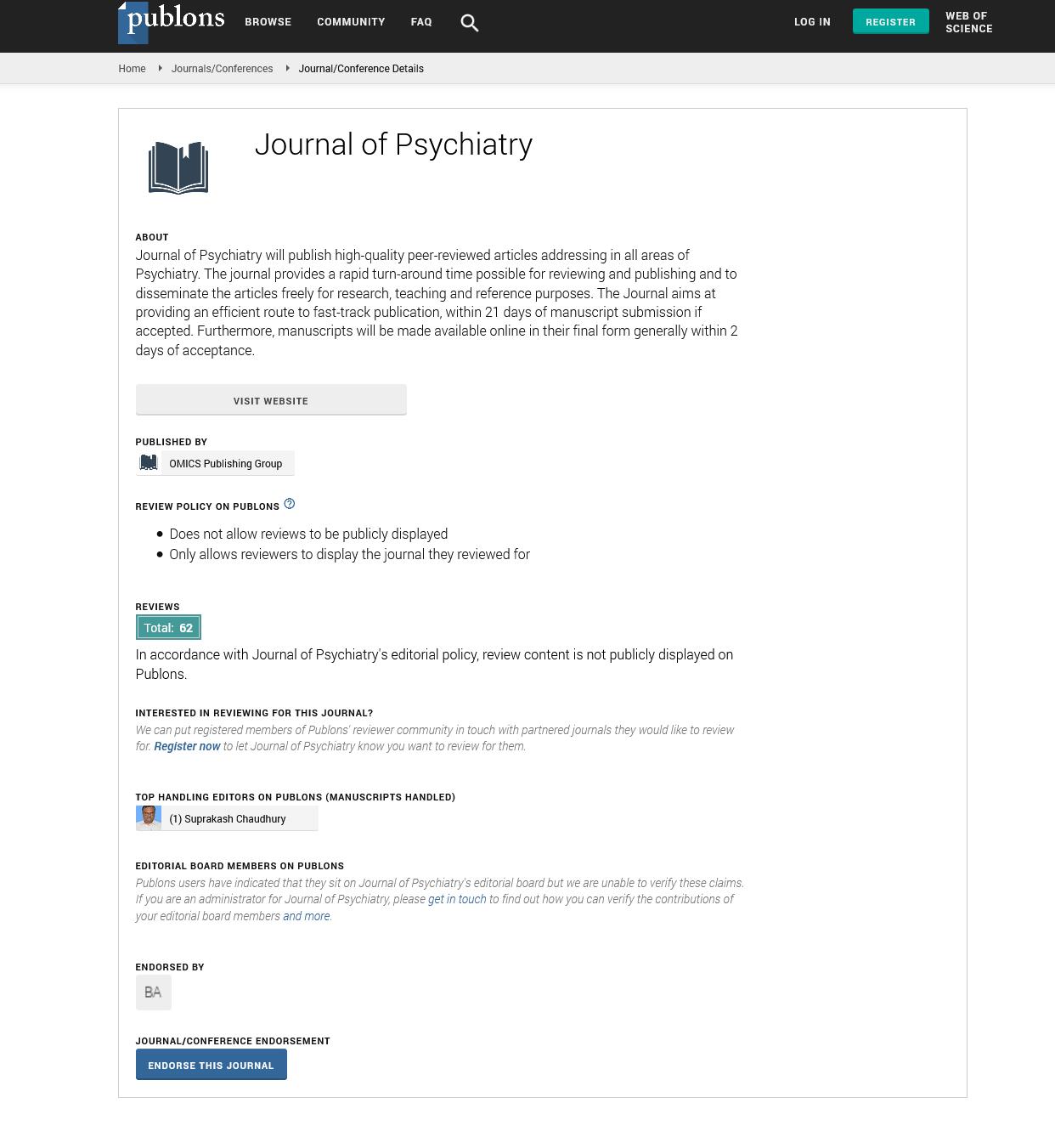Indexed In
- RefSeek
- Hamdard University
- EBSCO A-Z
- OCLC- WorldCat
- SWB online catalog
- Publons
- International committee of medical journals editors (ICMJE)
- Geneva Foundation for Medical Education and Research
Useful Links
Share This Page
Open Access Journals
- Agri and Aquaculture
- Biochemistry
- Bioinformatics & Systems Biology
- Business & Management
- Chemistry
- Clinical Sciences
- Engineering
- Food & Nutrition
- General Science
- Genetics & Molecular Biology
- Immunology & Microbiology
- Medical Sciences
- Neuroscience & Psychology
- Nursing & Health Care
- Pharmaceutical Sciences
Opinion Article - (2025) Volume 28, Issue 2
Phantom Signals: AI-Driven Biomarkers in Early Psychosis Detection
Chen Li*Received: 24-Feb-2025, Manuscript No. JOP-25-28815; Editor assigned: 26-Feb-2025, Pre QC No. JOP-25-28815; Reviewed: 12-Mar-2025, QC No. JOP-25-28815; Revised: 18-Mar-2025, Manuscript No. JOP-25-28815; Published: 26-Mar-2025, DOI: 10.35248/2167-0358.25.28.740
Description
Psychosis is a condition that can affect thoughts, emotions and behaviors in profound ways. Early signs often appear before a full episode occurs, but they can be difficult to detect. Subtle changes in speech, movement, or attention may go unnoticed by those around the person or even by the person themselves. Delayed diagnosis can lead to longer recovery times and greater disruption in a person's life. This has led researchers to explore new tools that can assist in identifying early indicators, even when they aren't obvious. Artificial intelligence is being studied as one such tool. With access to large amounts of data, AI systems can be trained to recognize patterns that may be linked to early psychosis. These systems do not rely on a single symptom but look at combinations of behaviors, speech patterns and other measurable signals. The term "biomarkers" refers to these signals, which can include anything from subtle voice changes to shifts in facial expressions or attention span.
Traditionally, early detection has been based on interviews, clinical observations and self-reported symptoms. While these methods are useful, they are also limited by human interpretation. AI-based tools aim to supplement this process by offering another layer of analysis. For example, a person might speak slightly slower, pause more often, or use certain types of words more frequently. These are things a human may not notice during a short visit, but an AI trained on hundreds or thousands of similar cases can detect patterns over time. In some research settings, voice recordings are used to measure changes in rhythm, tone and word choice. These changes can be early signs of altered thinking. Similarly, facial recognition software can track changes in eye contact, blinking rate, or microexpressions that reflect emotional state. Another area of interest is how individuals use their phones or devices—changes in typing speed, message content, or even how often they interact with others can all be informative.
Movement is another source of data. Small shifts in posture, speed of walking, or hand gestures during conversation can provide additional clues. AI systems can process this data in ways that are not practical for clinicians to do manually. Instead of relying on a single observation, they look at trends over days or weeks, creating a broader view of mental health changes. Ethics and consent are important parts of this research. People must be informed about what kind of data is being collected and how it will be used. There are questions about who gets access to the data, how it is stored and how accurate the predictions are. Incorrect assessments could lead to stress or mislabeling, while missing signs could delay treatment. Developers and researchers are working to balance these risks by refining models and creating clear guidelines for use.
Another challenge is making sure the systems are fair across different populations. Language, behavior and cultural norms vary widely. A system trained mostly on one group may not work well with others. To improve this, more diverse data sets are needed, along with regular checks to see how the systems perform across age groups, genders and ethnic backgrounds. These methods are still being tested in many parts of the world. While early results show potential, long-term studies are needed to know how well they work outside research labs. Even so, interest is growing among mental health professionals who see value in using technology to assist with early care.
Technology continues to change how we interact with health data. As AI systems learn to recognize patterns that humans may overlook, they may help identify risk sooner than traditional methods alone. This could allow for earlier conversations, more support and better planning for care. But these tools must be used thoughtfully, with clear understanding of their limits and a focus on the individual, not just the data. By studying how people speak, move and interact, AI may contribute to a better understanding of mental health patterns. It's not about replacing doctors or making decisions on behalf of individuals, but about providing information that can support earlier awareness and more personalized attention. The goal is to bring attention to quiet changes those that might otherwise go unnoticed before they grow into larger challenges.
Citation: Li C (2025). Phantom Signals: AI-Driven Biomarkers in Early Psychosis Detection. J Psychiatry.28:740.
Copyright: © 2025 Li C. This is an open-access article distributed under the terms of the Creative Commons Attribution License, which permits unrestricted use, distribution and reproduction in any medium, provided the original author and source are credited.

